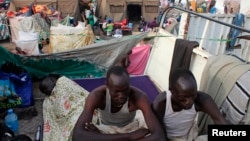The number of people fleeing South Sudan to neighboring countries continues to rise, as does the number of displaced people within the country. The U.N. refugee agency, UNHCR, said it’s expects the situation to only get worse.
UNHCR spokesman Adrian Edwards said more South Sudanese civilians are crossing borders to escape ongoing fighting and insecurity.
“At present, there are 78,000 people turning up at refugee sites in the surrounding region. 42,000 of these in Uganda, but we’re also seeing quite significant numbers in Ethiopia – some coming into Sudan, itself, the north – and others into Kenya, too. So, this is still a situation producing both internal displacement inside the country and new refugees into the region.”
The U.N. agency is gathering accounts of refugees’ experiences.
“If you talk to refugees, you hear eyewitness accounts of atrocities. You hear reports of shootings – of houses being burnt in many places. We are hearing of escalating food prices in many markets. So there are continued real problems around the country. And unfortunately all these factors are coming together and leading us to believe we’re likely at this stage to see further displacement still,” he said.
The number of displaced in South Sudan has risen sharply – up more than 150,000 since last week.
“The peace talks at the moment that are underway in Addis [Ababa] are not really producing any slowdown of displacement. You have large numbers of displaced – more than 350,000 inside the country – you have an existing refugee population of 230,000 people. So, you’re really talking about extraordinary large numbers of people in need of help,” Adrian said.
UNHCR is trying to determine the condition of those who’ve crossed into Sudan. However, gaining access to the region has been difficult.
“What we are hearing is that about 10,000 people have crossed into West and South Kordofan. These are two states just neighboring South Sudan. Many of these people are nomadic, so they’ve gone to different areas. The government of Sudan is saying only about 1300 of these people are actual refugees. Nonetheless, it’s very clear to us at present that there are urgent help needs there,” said Adrian.
UNHCR, the World Food Program, and other humanitarian agencies are trying to bring aid to those areas.
As Edwards mentioned, besides those fleeing the country and the internally displaced, there are 230,000 people from other countries at10 refugee camps in South Sudan. Some are of particular concern.
“Right up at the north there has been a large concentration of Sudanese refugees in a place called Yida. That has been affected by [in]security in recent weeks. Many of the agencies have pulled out of there. We have had the support of the U.N. peacekeeping mission in South Sudan to deploy additional security up there to allow some of the operations to resume for the 60 or so thousand people in that site,” he said.
Besides Yida, another camp in Unity State housing Sudanese refugees –Ajoung Thok – is also expected to receive emergency food aid soon.
UNHCR spokesman Adrian Edwards said more South Sudanese civilians are crossing borders to escape ongoing fighting and insecurity.
“At present, there are 78,000 people turning up at refugee sites in the surrounding region. 42,000 of these in Uganda, but we’re also seeing quite significant numbers in Ethiopia – some coming into Sudan, itself, the north – and others into Kenya, too. So, this is still a situation producing both internal displacement inside the country and new refugees into the region.”
The U.N. agency is gathering accounts of refugees’ experiences.
“If you talk to refugees, you hear eyewitness accounts of atrocities. You hear reports of shootings – of houses being burnt in many places. We are hearing of escalating food prices in many markets. So there are continued real problems around the country. And unfortunately all these factors are coming together and leading us to believe we’re likely at this stage to see further displacement still,” he said.
The number of displaced in South Sudan has risen sharply – up more than 150,000 since last week.
“The peace talks at the moment that are underway in Addis [Ababa] are not really producing any slowdown of displacement. You have large numbers of displaced – more than 350,000 inside the country – you have an existing refugee population of 230,000 people. So, you’re really talking about extraordinary large numbers of people in need of help,” Adrian said.
UNHCR is trying to determine the condition of those who’ve crossed into Sudan. However, gaining access to the region has been difficult.
“What we are hearing is that about 10,000 people have crossed into West and South Kordofan. These are two states just neighboring South Sudan. Many of these people are nomadic, so they’ve gone to different areas. The government of Sudan is saying only about 1300 of these people are actual refugees. Nonetheless, it’s very clear to us at present that there are urgent help needs there,” said Adrian.
UNHCR, the World Food Program, and other humanitarian agencies are trying to bring aid to those areas.
As Edwards mentioned, besides those fleeing the country and the internally displaced, there are 230,000 people from other countries at10 refugee camps in South Sudan. Some are of particular concern.
“Right up at the north there has been a large concentration of Sudanese refugees in a place called Yida. That has been affected by [in]security in recent weeks. Many of the agencies have pulled out of there. We have had the support of the U.N. peacekeeping mission in South Sudan to deploy additional security up there to allow some of the operations to resume for the 60 or so thousand people in that site,” he said.
Besides Yida, another camp in Unity State housing Sudanese refugees –Ajoung Thok – is also expected to receive emergency food aid soon.








